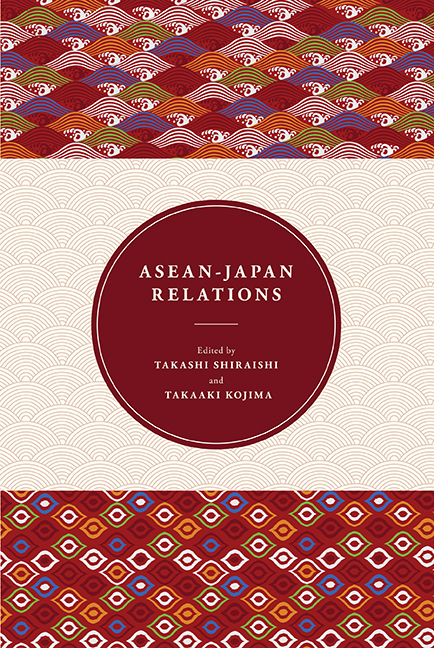Book contents
- Frontmatter
- Contents
- Preface
- About the Contributors
- 1 An Overview of Japan-ASEAN Relations
- 2 Japan's Relations with ASEAN
- 3 Approaches toward Regionalism: Japan, China and the Implications on ASEAN
- 4 The New Japan-ASEAN Partnership: Challenges in the Transformation of the Regional Context in East Asia
- 5 ASEAN-Japan Strategic Partnership and Regional Integration: Impacts and Implications
- 6 ASEAN-Japan Cooperation on Maritime Non-Traditional Security Issues: Toward a New Paradigm
- 7 Japan's Evolving Security Concerns in Maritime Southeast Asia: From Safety of Navigation to “Lake Beijing”
- 8 Evolution of Institutions and Policies for Economic Integration in East Asia: The Rise of China and Changes in the Regional Order
- 9 Managing Integration in East Asia: Behind Border Issues in Japan-ASEAN Trade Agreements
- 10 Regional Financial Cooperation in East Asia: Development and Challenges
- 11 Japanese Development Assistance to ASEAN Countries
- 12 Japanese Foreign Direct Investment in the ASEAN-4 Countries
- 13 Japan's Triple Tsunami
- 14 ASEAN-Japan Relations: A Singapore Perspective
9 - Managing Integration in East Asia: Behind Border Issues in Japan-ASEAN Trade Agreements
Published online by Cambridge University Press: 21 October 2015
- Frontmatter
- Contents
- Preface
- About the Contributors
- 1 An Overview of Japan-ASEAN Relations
- 2 Japan's Relations with ASEAN
- 3 Approaches toward Regionalism: Japan, China and the Implications on ASEAN
- 4 The New Japan-ASEAN Partnership: Challenges in the Transformation of the Regional Context in East Asia
- 5 ASEAN-Japan Strategic Partnership and Regional Integration: Impacts and Implications
- 6 ASEAN-Japan Cooperation on Maritime Non-Traditional Security Issues: Toward a New Paradigm
- 7 Japan's Evolving Security Concerns in Maritime Southeast Asia: From Safety of Navigation to “Lake Beijing”
- 8 Evolution of Institutions and Policies for Economic Integration in East Asia: The Rise of China and Changes in the Regional Order
- 9 Managing Integration in East Asia: Behind Border Issues in Japan-ASEAN Trade Agreements
- 10 Regional Financial Cooperation in East Asia: Development and Challenges
- 11 Japanese Development Assistance to ASEAN Countries
- 12 Japanese Foreign Direct Investment in the ASEAN-4 Countries
- 13 Japan's Triple Tsunami
- 14 ASEAN-Japan Relations: A Singapore Perspective
Summary
INTRODUCTION
Economic integration in East Asia has been undergoing a massive transformation for more than a decade. The search for markets, combined with a quest for low-cost production sites, has resulted in a set of formal trade agreements — at the regional, plurilateral, and bilateral levels — among countries in the region. Not only the number of trade agreements but also their content has evolved to cover various aspects aside from trade liberalization. This transformation reflects the complexity of problems surrounding economic integration in East Asia, as well as the need for better governance and discipline.
When talking about regional economic integration and the rise of regionalism in East Asia, one cannot neglect the importance of economic relations between Japan and Southeast Asian countries. Market-driven integration in the region was initiated, to a large extent, by the economic relations of Japanese business groups with their ASEAN counterparts. The relations created networks of trade, production, investment, and services spanning across developing countries of ASEAN and later included other countries in East Asia. Formal economic cooperation and trade agreements between Japan and ASEAN countries, at the regional and bilateral levels, also set the practice of including new features of free trade agreements (FTAs) known as behind-border issues (BBIs). BBIs include provisions on investments, competition policy, intellectual property rights, and other non-trade issues. The inclusion of BBIs into ASEAN-Japan FTAs created a 21st century regionalism that is different from the relationships created by traditional trade agreements.
This paper is an attempt to examine regional economic integration in East Asia, particularly between Japan and ASEAN countries, and how it has evolved into 21st century regionalism. The premise is that economic relations, while initiated by market forces, require some kind of management to address emerging issues and problems. This can be delivered by providing various elements within the framework of FTAs.
We begin the analysis by looking at the nature of economic relations between Japan and ASEAN countries and how formal trade agreements emerged. This is done through both historical and analytical assessment. We then explore more technical details of trade agreements by looking at various new behind-border issues in FTAs between Japan and ASEAN countries and place them in the context of implementing economic integration in the region.
- Type
- Chapter
- Information
- ASEAN-Japan Relations , pp. 160 - 183Publisher: ISEAS–Yusof Ishak InstitutePrint publication year: 2013



